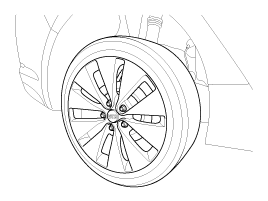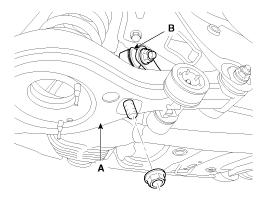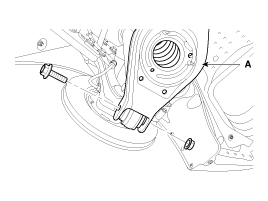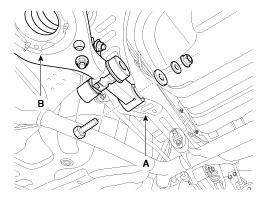Kia Optima Hybrid: Rear Suspension System / Rear Lower Arm Repair procedures
| Replacement |
| 1. |
Remove the rear wheel & tire.
|
| 2. |
Loosen the nut and then remove the rear stabilizer link (B) from the rear lower arm (A).
|
| 3. |
Loosen the bolt & nut and then remove the rear lower arm (A) from the rear axle.
|
| 4. |
Loosen the bolt & nut and then remove the rear lower arm (B) from the sub frame (A).
|
| 5. |
Installation is the reverse of removal.
|
| Inspection |
| 1. |
Check the bushing for wear and deterioration. |
| 2. |
Check the rear lower arm for deformation. |
| 3. |
Check the coil spring and spring pad for deterioration and deformation. |
| 4. |
Check for all bolts and nut. |
 Rear Upper Arm Repair procedures
Rear Upper Arm Repair procedures
Replacement 1. Remove the rear wheel & tire. Tightening torque: 88.3 ~ 107.9N.m(9.0 ~ 11.0kgf.m, 65.1 ~ 79.6lb-ft) Be careful not to damage the hub bolts when removing the rear wheel ...
 Rear Stabilizer Bar Repair procedures
Rear Stabilizer Bar Repair procedures
Replacement 1. Remove the rear wheel & tire. Tightening torque: 88.3 ~ 107.9N.m (9.0 ~ 11.0kgf.m, 65.1 ~ 79.6lb-ft) Be careful not to damage the hub bolts when removing the rear wheel ...
Other information:
Kia Optima Hybrid (TF HEV) 2016-2020 Service Manual: Balance Shaft & Oil Pump Repair procedures
Removal Balance Shaft Module (BSM) Chain System 1. Remove the timing chain. (Refer to Timing system in this group) 2. Install a stopper pin (A) after compressing the balance shaft chain tensioner. 3. Remove the balance shaft chain hydraulic tensioner (B). 4. Remove the balance shaft chain tensioner arm ...
Kia Optima Hybrid (TF HEV) 2016-2020 Service Manual: Line Pressure Control Solenoid Vale Repair procedures
Inspection 1. Turn ignition switch OFF. 2. Remove the air duct (A). Tightening torque: 7.8 ~ 9.8 N.m (0.8 ~ 1.0 kgf.m, 5.8 ~ 7.2 lb-ft) 3. Remove the air cleaner assembly. (1) Disconnect the breather hose (A). (2) Disconnect the air intake hose (B) and then remove the air cleaner assembly (C). Tightening ...





